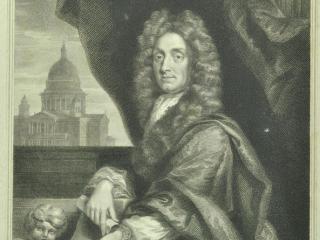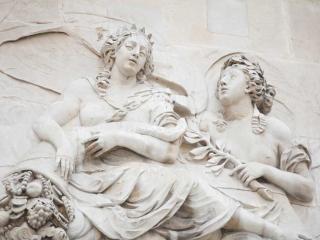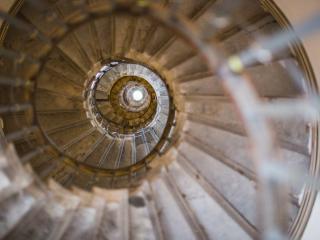Dr Robert Hooke is one of the masterminds behind the design of The Monument to the Great Fire of London. Discover more about his life, architectural achievements and scientific discoveries.
The great mind behind The Monument
The great mind behind The Monument
Dr Robert Hooke is one of the masterminds behind the design of The Monument to the Great Fire of London. Discover more about his life, architectural achievements and scientific discoveries.
Dr. Robert Hooke was an English scientist, architect and polymath best known for designing The Monument to the Great Fire of London and the Royal Observatory Greenwich, both in partnership with Sir Christopher Wren.
He was instrumental in the rebuilding of London after the great fire in 1666. He invented the microscope and was the first to visualise micro-organisms alongside many other contributions to scientific research.
Robert Hooke was born on 18 July 1635 in Freshwater, on the Isle of Wight. He was the youngest of four children.
As a child, Hooke was 'sickly' and unable to attend school regularly, often being taught at home by his father, an Anglican priest, who declared his son’s work 'that of a genius’. From an early age, Hooke was fascinated by observation, mechanical works and drawing.
When his father died in 1648, Hooke was left an inheritance of £40, which was a significant amount at the time. This allowed him to move to London to become an apprentice and enrol at Westminster School. There, he mastered Latin and Greek, and began his lifelong study of mechanics.
At the age of 18, in 1653, Hooke became a student at Oxford’s Christ Church College, where he worked as an assistant to Dr Thomas Willis. There, he focused on science, building telescopes, studying fossils and evolution.
From around 1655 to 1662, Hooke was employed as an assistant to natural philosopher and inventor Robert Boyle. He was of great assistance on improving the design of Boyle’s air pump, the ‘machina Boyleaba’ or ‘Pneumatic Engine’, which was finished in 1659.
Hooke was awarded his Master of Arts degree between 1662-3.
In 1660, Hooke discovered the law of elasticity (Hooke's Law), which explains the force needed to extend or compress a spring by a certain distance.
One of Hooke’s biggest scientific achievements was the invention of the modern microscope. Hooke is also credited for the invention of the compound microscope, the wheel barometer and the hydrometer.
Whilst Hooke was predominantly an astronomer, he turned his attention to studying the ‘invisible’ world under his microscope, and wrote and illustrated one of the greatest scientific books of all time, ‘Micrographia’. In the book, he coined the term ‘cell’ to describe the smallest components of these living creatures he observed. It also contained a number of detailed drawings of his microscopic discoveries.
Image: Robert Hooke's microscope, from an engraving featured in his book, 'Micrographia'. ©Wikimedia Commons/Public domain
In addition to his extensive work at cellular level and around cell theory, Hooke had considerable success in a wide range scientific fields including mechanics and acoustics. For example, in 1680, he was the first to observe the nodal patterns created by vibrations in a rigid surface. He ran a bow along the edge of a glass plate covered in flour to reveal what is now known as Chladni Figures.
Hooke also contributed extensively into research around gravitation, horology (the study of timekeeping), palaeontology, astronomy, and the human memory.
Following the Great Fire of London in 1666, Hooke was assigned the role of Surveyor to the City of London and Chief Assistant to Sir Christopher Wren to help rebuild London. He collaborated with Wren to design and build The Monument.
In 1675, Hooke built the first Montagu House in Bloomsbury, London, but the opulent house was destroyed by a fire in 1686. The house was then rebuilt (by a little-known architect, Pouget) and sold to the British Museum in 1759. It was subsequently demolished in the 1840s to make way for the current British Museum building.
Hooke, alongside Wren was also responsible for the Royal Observatory in Greenwich. Flamsteed House was the first of part the Royal Observatory to be completed and was intended as a home for the Astronomer Royal. It is believed Hooke and Flamsteed, the first Astronomer Royal, did not get along, a dislike that was heightened when they were forced into co-operation in 1676.
Alongside Wren, Hooke was in charge for other architectural achievements following The Great Fire, including Bethlem Royal Hospital, The Royal College of Physicians and a number of manors and halls.
Image: A hand-coloured aquatint of Flamsteed House, at the Royal Observatory Greenwich, 1824 © National Maritime Museum
With both Hooke and Wren being keen astronomers, they designed The Monument to serve a scientific function as a zenith telescope (see below) with an underground laboratory for their scientific experiments. This intended purpose can still be seen today in the construction of The Monument with its spiral staircase, which has no central column as well as the observation chamber below ground level. Unfortunately, The Monument was never successful in its scientific endeavours as the movement of the column – either from wind or traffic vibrations – made it unsuitable.
Hooke was deeply involved with The Monument’s design and also responsible for the commissioning of the various sculptures that adorn its pedestal, including the frieze carved by Danish-born sculptor Caius Gabriel Cibber.
Image: Detail of The Monument's Frieze, carved by Caius Gabriel Cibber
A zenith telescope is a type of telescope designed to point straight up towards the zenith - an imaginary point directly above a particular location on the imaginary celestial sphere. The zenith telescope built inside The Monument included a shaft meant for use as a zenith telescope.
Hooke was a longstanding member of the Royal Society and worked as its Curator of Experiments for around 40 years. He was also Professor of Geometry at Gresham College. Robert Hooke died aged 67 on 3 March 1703.
In his later years, Hooke became tied up with heated intellectual disputes with Isaac Newton, which may have contributed to his relative obscurity in history. It is alleged that after Hooke’s death, Newton questioned his legacy and, as president of the Royal Society at the time, destroyed or failed to preserve the only known portraits of Hooke. As such, there are no known portraits of Robert Hooke from when he was alive.
Hooke never married or had children. His will was never found, so his assets were passed to his cousin Elizabeth Stephens. He was buried at St Helen’s, Bishopsgate in the City of London, but the precise location of his grave is unknown because of bombings during the Second World War. There is also a memorial for Hooke inside Westminster Abbey, as well as a crater on the Moon and an asteroid (3514 Hooke), both named in his honour.


